Gaming Performance
The big question here is whether or not the CPU is going to be the bottleneck with the selected graphics card. As you'll see, the processor can be a limiting factor in the stock systems, depending on the game, but once we start overclocking everything begins to even out.

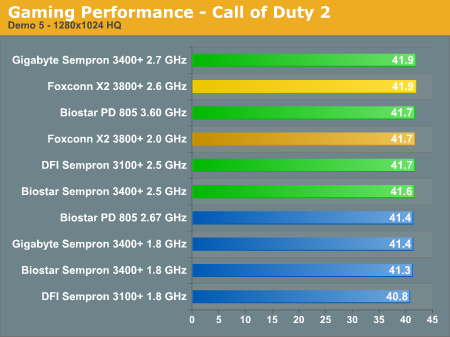
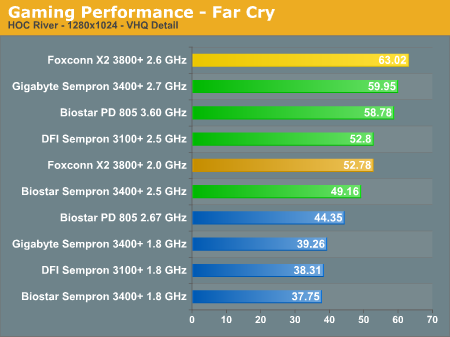
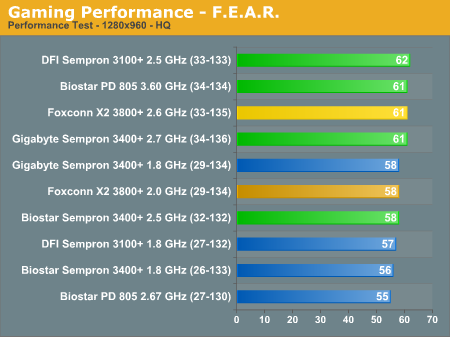
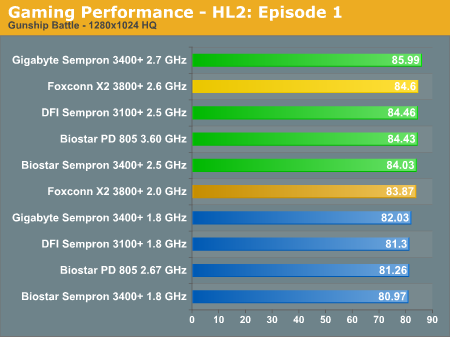
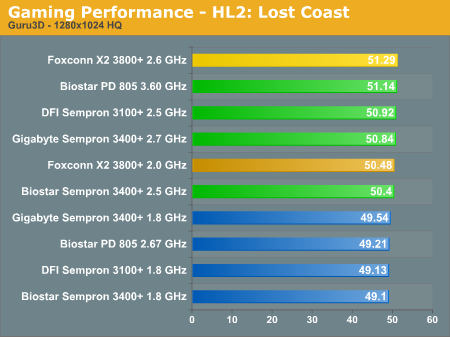
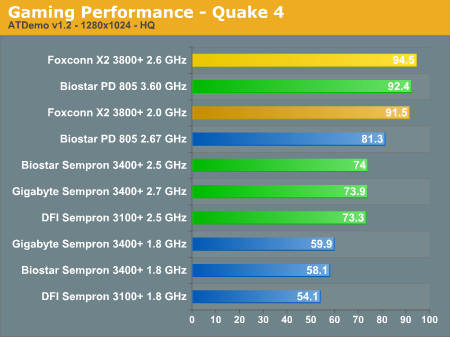

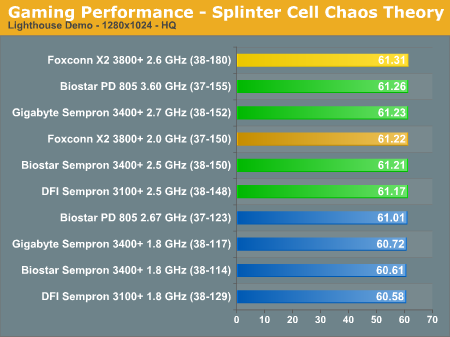
We could have continued running additional benchmarks, but basically it's pretty clear that the 7600 GT has reached its limits in many of the games with the overclocked processors. The good news is that all of the games were very playable at 1280x1024 resolution, so unless you demand things like antialiasing and higher resolutions, this graphics card should be sufficient. In fact, quite a few games can even run well with antialiasing enabled and/or higher resolutions.
Far Cry, Serious Sam 2, Quake 4, and Battlefield 2 all benefit from having a faster processor, but you can see that the graphs begin to flatten out at the top. (We're not quite sure what's going on with the X2 Battlefield 2 performance, but repeated testing garnered the same results. Apparently, that particular game really does well on the X2 chips.) Upcoming titles will likely require more graphics processing power, but in the future you will also be able to upgrade to a faster GPU for less money than that level of performance currently costs. The two SMP aware games that we tested showed differing results. Call of Duty 2 simply taxes the graphics card too much to really benefit from a faster processor. Quake 4 on the other hand shows some significant performance improvements, though once we enabled antialiasing most of those disappeared.
Taking a look at the performance offered by the various platforms, all of the overclocked systems perform very well. Without overclocking, the Sempron AM2 system is surprisingly at the bottom of the list when we used the Biostar motherboard, which is why we also tested with the Gigabyte board. The difference isn't huge, but the Gigabyte board is almost always 3% to 10% faster at the same clock speed and memory settings. This almost certainly points to a less optimized BIOS in the Biostar board, which isn't too surprising as most optimization efforts are focused on the enthusiast motherboards rather than the value offerings.
While historically AMD's K8 architecture has outperformed Intel's NetBurst architecture in games, the Pentium D 805 generally places ahead of the two Sempron chips, even with the slower front side bus. It would appear that the reduced L2 cache on the Sempron chips versus the larger L2 cache on the Pentium D results in the 805 being better overall for gaming. NetBurst has always done very poorly with reduced amounts of L2 cache (just take a look at the performance of the Celeron chips), but with the budget priced Smithfield core Intel jumps back into the lead for this price point.
Looking at the overclocked results again, most of the scores are in line with what we expected. Sempron AM2 is able to surpass Sempron 754 when we're not GPU limited, due at least in part to the higher clock speed we attained. It would also appear that higher clock speeds place more of a burden on system memory, so the dual channel memory comes out ahead. We would expect Sempron AM2 to be better overall, as it runs on a newer platform and we used a more expensive processor. Really, though, if you already have a decent 754 system, upgrading certainly isn't required (yet). If Athlon X2 on socket 939 wasn't enough to get you to upgrade, Athlon X2 on AM2 doesn't change things much.
The big question here is whether or not the CPU is going to be the bottleneck with the selected graphics card. As you'll see, the processor can be a limiting factor in the stock systems, depending on the game, but once we start overclocking everything begins to even out.









We could have continued running additional benchmarks, but basically it's pretty clear that the 7600 GT has reached its limits in many of the games with the overclocked processors. The good news is that all of the games were very playable at 1280x1024 resolution, so unless you demand things like antialiasing and higher resolutions, this graphics card should be sufficient. In fact, quite a few games can even run well with antialiasing enabled and/or higher resolutions.
Far Cry, Serious Sam 2, Quake 4, and Battlefield 2 all benefit from having a faster processor, but you can see that the graphs begin to flatten out at the top. (We're not quite sure what's going on with the X2 Battlefield 2 performance, but repeated testing garnered the same results. Apparently, that particular game really does well on the X2 chips.) Upcoming titles will likely require more graphics processing power, but in the future you will also be able to upgrade to a faster GPU for less money than that level of performance currently costs. The two SMP aware games that we tested showed differing results. Call of Duty 2 simply taxes the graphics card too much to really benefit from a faster processor. Quake 4 on the other hand shows some significant performance improvements, though once we enabled antialiasing most of those disappeared.
Taking a look at the performance offered by the various platforms, all of the overclocked systems perform very well. Without overclocking, the Sempron AM2 system is surprisingly at the bottom of the list when we used the Biostar motherboard, which is why we also tested with the Gigabyte board. The difference isn't huge, but the Gigabyte board is almost always 3% to 10% faster at the same clock speed and memory settings. This almost certainly points to a less optimized BIOS in the Biostar board, which isn't too surprising as most optimization efforts are focused on the enthusiast motherboards rather than the value offerings.
While historically AMD's K8 architecture has outperformed Intel's NetBurst architecture in games, the Pentium D 805 generally places ahead of the two Sempron chips, even with the slower front side bus. It would appear that the reduced L2 cache on the Sempron chips versus the larger L2 cache on the Pentium D results in the 805 being better overall for gaming. NetBurst has always done very poorly with reduced amounts of L2 cache (just take a look at the performance of the Celeron chips), but with the budget priced Smithfield core Intel jumps back into the lead for this price point.
Looking at the overclocked results again, most of the scores are in line with what we expected. Sempron AM2 is able to surpass Sempron 754 when we're not GPU limited, due at least in part to the higher clock speed we attained. It would also appear that higher clock speeds place more of a burden on system memory, so the dual channel memory comes out ahead. We would expect Sempron AM2 to be better overall, as it runs on a newer platform and we used a more expensive processor. Really, though, if you already have a decent 754 system, upgrading certainly isn't required (yet). If Athlon X2 on socket 939 wasn't enough to get you to upgrade, Athlon X2 on AM2 doesn't change things much.










56 Comments
View All Comments
JarredWalton - Monday, July 10, 2006 - link
Drop the $180 GPU and throw in a $50 GPU and you've got a non-gaming platform.mino - Wednesday, July 12, 2006 - link
Wrong,i.e.: changes to make 754 config a good budget PC:
drop DFI MB, drop the GPU, put in quality ATI Xpress200 or Geforce 6100 MB
drop that dual channel Patriot nonsense for singel channel s754, put in Kinkston/
Corsair 1GB stick of DDR400 CL3
drop that insane 400W PSU(100W system), drop in budget case, drop in FSP300-60GLN
example:
CPU: Sempron 2800+ ~$50
MB: JetWay A200GDMS ~$70 or some Geforce6100 board
RAM: 1GB brand DDR400 ~$90
HDD: any 250G ~$80
DVD: NEC 4571 ~$35 or any you like
case: ASUS TM250 ~$30 or any generic case without PSU
PSU: FSP300-60GLN ~$30
Final price: <= $400
You can drop some better GPU later but such a system will be with you for a long time.
As someone wrote above, your configs are good budget GAMER/OVERCLOCKER choices. Not budget PC choices.
JarredWalton - Wednesday, July 12, 2006 - link
But I would quantify my system as a "better" budget system - the extra $200 or so goes a long ways towards improving features and performance. Again, you don't *have* to buy these systems, but they are what I had available and you can see performnace (stock and OC'ed). It's something a bit different from our regular budget buyers' guides.mino - Thursday, July 13, 2006 - link
Almost forgot,I really appreciated the review, realy.
Just not for the text part, instead for the numbers and mostly the configs being tested.
mino - Thursday, July 13, 2006 - link
IMHO we have a common attitude for system config creation. But a different view on what a budget PC is. For me, it is a -as cheap as possible- workhorse, for you, a gaming machine able to work.My intention was just to show off that it is not so simple - like change the GPU and it is a classic budget system. IMHO you know that it is more complicated, but many readers do not(an the article supports them here).
the message:
"To build a good, balanced PC is a system solution problem, not a component solution one."
Best regards.
mino - Wednesday, July 12, 2006 - link
Wrong,i.e.: changes to make 754 config a good budget PC:
drop DFI MB, drop the GPU, put in quality ATI Xpress200 or Geforce 6100 MB
drop that dual channel Patriot nonsense for singel channel s754, put in Kinkston/
Corsair 1GB stick of DDR400 CL3
drop that insane 400W PSU(100W system), drop in budget case, drop in FSP300-60GLN
you've got:
CPU: Sempron 2800+ $50
MB:
mino - Wednesday, July 12, 2006 - link
this post was unintentional, gog give us EDIT :)Josh7289 - Monday, July 10, 2006 - link
So, the Pentium D's are going even lower, when the X2's lower as well? What about the other single cores from Intel and AMD, are they lowering with Core 2 Duo's launch?Looking back at that article from one and a half years ago. it's pretty cool to see what one can get today for less money than what one could get back then. I remember reading that article last year shortly before I built the PC I use now and using it as a kind of guideline, even though it was a few months old then.
Anyway, this spell check on Firefox 2.0 Beta 1 is freaking sweet. :)
PC Surgeon - Monday, July 10, 2006 - link
The review overall was very good. But I do have one problem and it has to do with this statement:
"Still, we're inclined to recommend socket AM2 right now, as we have yet to see any budget socket 775 motherboards available that will support Core 2 Duo chips.
Oh yeah? Well what about this one?
ASRock 775Dual-VSTA $58.99 www.newegg.com/Product/Product.asp?Item=N82E16813157092
It supports Conroe, DDR, DDRII, AGP, PCI-e....which to me is somewhat the equevelent of the ASROCK 939DUAL SATAII. For people with older systems that have DDR, or AGP, the 775Dual-VSTA is the board that can make the transition a little cheaper.
Why you guys didn't recommend this board I don't know...maybe you didnt know about it? Or worse (and I doubt this is true) it was showing AMD bias.
That's my bone to pick....
JarredWalton - Monday, July 10, 2006 - link
I will let Gary's review explore overclocking on the ASRock motherboard. I really have no idea how it will perform, and the truth is that I started working on this article several weeks ago. If I knew for sure which budget motherboards can run Core 2 Duo and overclock well, I would be happy to recommend such a motherboard. We'll probably have to wait a few more weeks to get a clear feel for that market.